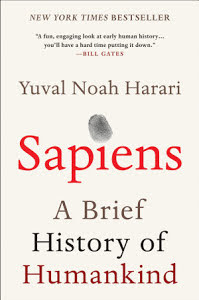Sapiens
I only started reading this book a few days ago, but I’m already marveling at the knowledge it holds and the broad sweep of history it’s providing. Sapiens is about Homo sapiens, our species, and the first chapter describes some of our earliest cousins:
There was Homo floresiensis, a dwarf species from the Indonesian island of Flores that grew to only three and a half feet tall; Homo denisova, a species just discovered eight years ago in Denisova Cave in Siberia; Homo erectus, from East Asia, the most durable species ever, which survived for close to two million years. “It is doubtful whether Homo sapiens will still be around a thousand years from now,” writes the author, Yuval Noah Harari, “so two million years is really out of our league.”
Now there’s a line (the italics are mine) that caught my attention. A thousand years is only 12 generations from now, give or take. And Harari, whose erudition is such that he doesn’t need fancy language, casually drops in the fact that he doesn’t think we’ll be around that long.
The most fascinating cousin is Homo neanderthalensis, aka Neanderthals. As you might notice, we are the only Homo species on the planet now. Which raises the question, what happened to the others? At first, Harari explains, it was assumed Sapiens just killed everyone else off. But there was also the theory that some interbreeding went on, especially with Neanderthals.
And indeed, that seems to be the case. DNA research has shown that 1 to 4 percent of human DNA in the modern populations of the Middle East and Europe is Neanderthal DNA.
Still, we mostly killed off these and all our cousins. Tolerance is not one of Sapiens strong suits, Harari says, and Neanderthals were “too familiar to ignore, too difficult to tolerate.”
Tune in for later posts as my feeble Sapiens brain makes it way through this fascinating book.
